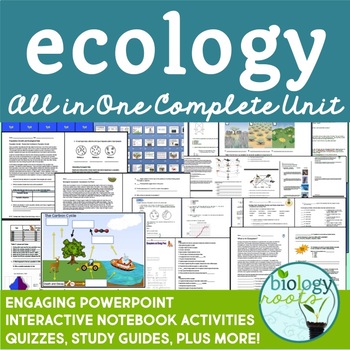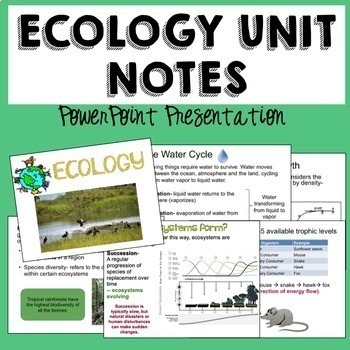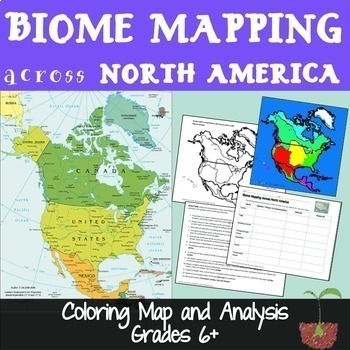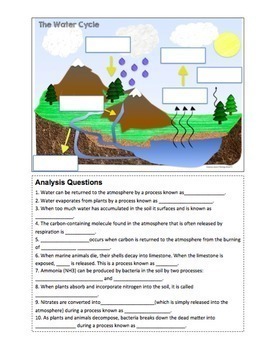Ecology Unit Bundle
- Zip
- Google Apps™

What educators are saying
Also included in
- A biology curriculum bundle that has everything you need to teach high school biology for the entire year. This year long biology curriculum bundle includes models, case studies, task cards, labs, PowerPoints, study guides, projects, and now with the introduction of the model-based learning journalPrice $379.00Original Price $534.88Save $155.88
Description
This unit supports distance learning- a PDF with links to Google Drive is included in order to assign student activities remotely.
Ecology 3 week unit with 200+ pages including interactive notebook activities, task cards, review games. Covers ecosystems, energy flow, food webs, population growth, biogeochemical cycles and biomes.
This unit can be used as a stand alone curriculum or as part of an existing curriculum.
4-5 week unit plan with answer keys and unit planner included!
✽✽ Ecology Notes ✽✽
1 power point divided into 5 sections)
covers the following:
-Introduction to Ecology (basic vocabulary and succession)
-Energy Flow in Ecosystems (primary productivity, trophic levels, producers/consumers, energy pyramids, biomass)
- Population Growth (dispersion, density, exponential vs. logistic growth, determining growth rate, density-independent vs. density dependent factors, r-strategists vs. K-strategists).
- Biogeochemical Cycles: Water, Carbon, Nitrogen
-Communities: Niche- fundamental vs. realized, invasive species, symbiosis + coevolution.
✽✽ Practice Sheets (Classwork and Homework) include: ✽✽
-What is an Ecosystem? - distance learning
-Primary Succession Cut-n-Paste Timeline - distance learning
-Ecological Succession of a Pond- distance learning
-Energy Flow in Ecosystems - distance learning
-Food Web Visual Vibes- distance learning
-Population Growth - distance learning
-Population Growth and Data - distance learning
-Predation or Starvation?
Drawing Biogeochemical Cycles - distance learning
Biogeochemical Cycles and You - distance learning
Human Impact PowerPoint Presentation
Worksheets: Invasive Species, Climate Change and Agriculture, Dams
Rubric: Invasive Species Project
Deforestation online lesson
✽✽ Interactive Notebook Activities ✽✽
There are 15+ activities to choose from- designed for INBs or can be used as independent projects.
✽✽ Ecology Web Quests ✽✽
Human Population Growth Web Quest
**Study Tool**
✽✽ Quizzes ✽✽
5 Quizzes: 3 open note quizzes (can be modified to suit your style) + 2 quizzes
1 Unit Test (multiple choice and open response)
✽✽ Viewing Guides for your Viewing Pleasure! ✽✽
Bonus! 2 Viewing Guides (Parasites: Eating Us Alive; Cane Toads: An Unnatural History)
✽✽ All About Biomes! ✽✽
Biome Notes (world biomes); Biome Mapping Across North America, and Biodiversity Bingo.
Purchased separately this bundle would cost $57.94. Get it here for nearly a 33% discount at $38.99
➩ ➩ Looking for the entire curriculum? You can get this unit along with several others in my Big Biology Curriculum Bundle
Related NGSS Standards:
- HS-LS2-1: Use mathematical and/or computational representations (graphs, charts, histograms, and population changes gathered from simulations or historical data sets) to support explanations of factors that affect carrying capacity of ecosystems at different scales.
- HS-LS2-2: Use mathematical representations to support and revise explanations based on evidence about factors affecting biodiversity and populations in ecosystems of different scales.
- HS-LS2-3: Construct and revise an explanation based on evidence for the cycling of matter and flow of energy in aerobic and anaerobic conditions.
- HS-LS2-4: Use mathematical representations to support claims for the cycling of matter and flow of energy among organisms in an ecosystem.
- HS-LS2-5: Develop a model (simulations and mathematical models) to illustrate the role of photosynthesis and cellular respiration in the cycling of carbon among the biosphere, atmosphere, hydrosphere, and geosphere.
- HS-LS2-6: Evaluate the claims, evidence, and reasoning that the complex interactions in ecosystems maintain relatively consistent numbers and types of organisms in stable conditions, but changing conditions may result in a new ecosystem.
- HS-LS2-7: Design, evaluate, and refine a solution for reducing the impacts of human activities on the environment and biodiversity.
- HS-LS2-8: Evaluate the evidence for the role of group behavior on individual and species’ chances to survive and reproduce.
- HS-LS4-6: Create or revise a simulation to test a solution to mitigate adverse impacts of human activity on biodiversity.
Vanessa Jason Biology Roots
For single classroom only; not to be shared publicly (do not create publicly accessible links).
Copying for more than one teacher, classroom, department, school, or district is prohibited. Failure to comply is a violation of the DMCA (Digital Millennium Copyright Act).
☆☆Follow me on☆☆






